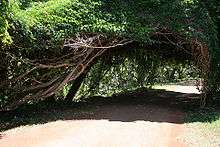Liana




A liana is any of various long-stemmed, woody vines that are rooted in the soil at ground level and use trees, as well as other means of vertical support, to climb up to the canopy to get access to well-lit areas of the forest.[1] Lianas are characteristic of tropical moist deciduous forests (especially seasonal forests), but may be found in temperate rainforests. There are also temperate lianas, for example the members of the Clematis or Vitis (wild grape) genera. Lianas can form bridges amidst the forest canopy, providing arboreal animals with paths across the forest. These bridges can protect weaker trees from strong winds. Lianas compete with forest trees for sunlight, water and nutrients from the soil.[2]
The term "liana" is not a taxonomic grouping, but rather a description of the way the plant grows – much like "tree" or "shrub". Lianas may be found in many different plant families. One way of distinguishing lianas from trees and shrubs is based on the stiffness, specifically, the Young's modulus of various parts of the stem. Trees and shrubs have young twigs and smaller branches which are quite flexible and older growth such as trunks and large branches which are stiffer. A liana often has stiff young growths and older, more flexible growth at the base of the stem.[3]
Important Genera
Described genera containing liana species include:
- Gnetum spp.
- Mendoncia spp.
- Ancistrocladus spp.
- Uvaria spp.
- Odontadenia spp.
- Aristolochia spp.
- Anemopaegma spp.
- Capparis spp.
- Cissus spp. (e.g. C. hypoglauca), "water vines"
- Tetrastigma spp.
- Connarus spp.
- Doliocarpus spp.[2] (Neotropical "water vines")
- Dioscorea spp.: the yam family (e.g. D. sylvatica)
Fabaceae: perhaps not surprisingly, leguminous vines are well represented:
- Caesalpinia spp.: some, including "cat’s claws" (e.g. C. bonduc, C. mimosoides, C. sumatrana)
- Lasiobema (=Bauhinia) scandens, etc., "monkey ladders" or "snake climbers"
- Pterolobium spp.
- Machaerium spp.
- Mucuna spp. (M. bennettii: the scarlet/red jade vine)
- Strongylodon spp. (includes S. macrobotrys: the jade vine)
- Acacia some spp.: e.g. A. concinna
- Entada spp. (box beans)
- Dalbergia armata: of subtropical Africa (note: many species in this genus are trees)
- Strychnos spp. e.g. S. axillaris
- rattans: several genera including:
- Calamus spp.
- Daemonorops spp.
- Moutabea: especially M. aculeata
- Paullinia spp.
- Schlegelia spp.
- Smilax spp.
Ecology
Lianas compete intensely with trees, greatly reducing tree growth[4] and tree reproduction,[5] greatly increasing tree mortality,[6] preventing tree seedlings from establishing,[4] and altering the course of regeneration in forests.[7] Lianas also provide access routes in the forest canopy for many arboreal animals, including ants and many other invertebrates, lizards, rodents, sloths, monkeys, and lemurs. For example, in the Eastern tropical forests of Madagascar, many lemurs achieve higher mobility from the web of lianas draped amongst the vertical tree species. Many lemurs prefer trees with lianas for their roost sites.[8] Lianas also provide support for trees when strong winds blow.[9] However, they may be destructive in that when one tree falls, the connections made by the lianas may cause many other trees to fall.[9]
As noted by Charles Darwin, because lianas are supported by other plants, they may conserve resources that other plants must allocate to the development of structure and use them instead for growth and reproduction. In general, lianas are detrimental to the trees that support them: growth rates are lower for trees with lianas, they directly damage hosts by mechanical abrasion and strangulation, render hosts more susceptible to ice and wind damage, and increase the probability that the host tree falls. Lianas also make the canopy of trees more accessible to animals which eat leaves. Because of these negative effects, trees which remain free of lianas are at an advantage; some species have evolved characteristics which help them avoid or shed lianas.[10]
References
- ↑ "liana". Encyclopædia Britannica.
- 1 2 Schnitzer, S. A.; Bongers, F. (2002). "The ecology of lianas and their role in forests". Trends in Ecology and Evolution. 17 (5): 223–230. doi:10.1016/S0169-5347(02)02491-6.
- ↑ Lahaye, R.; Civeyrel, L.; Speck, T.; Rowe, N. P. (2005). "Evolution of shrub-like growth forms in the lianoid subfamily Secamonoideae (Apocynaceae s.l.) of Madagascar: phylogeny, biomechanics, and development". American Journal of Botany. 92 (8): 1381–96. doi:10.3732/ajb.92.8.1381. PMID 21646158.
- 1 2 Schnitzer, S. A.; Carson, W. P. (2010). "Lianas suppress tree regeneration and diversity in treefall gaps". Ecology Letters. 13 (7): 849–857. doi:10.1111/j.1461-0248.2010.01480.x. PMID 20482581.
- ↑ Wright, S. J.; Jaramillo, A. M.; Pavon, J.; Condit, R.; Hubbell, S. P.; Foster, R. B. (2005). "Reproductive size thresholds in tropical trees: variation among individuals, species and forests". Journal of Tropical Ecology. 21 (3): 307–315. doi:10.1017/S0266467405002294.
- ↑ Ingwell, L. L.; Wright, S. J.; Becklund, K. K.; Hubbell, S. P.; Schnitzer, S. A. (2010). "The impact of lianas on 10 years of tree growth and mortality on Barro Colorado Island, Panama". Journal of Ecology. 98 (4): 879–887. doi:10.1111/j.1365-2745.2010.01676.x.
- ↑ Schnitzer, S. A.; Dalling, J. W.; Carson, W. P. (2000). "The impact of lianas on tree regeneration in tropical forest canopy gaps: Evidence for an alternative pathway of gap-phase regeneration". Journal of Ecology. 88 (4): 655–666. doi:10.1046/j.1365-2745.2000.00489.x.
- ↑ Rendigs, A.; Radespiel, U.; Wrogemann, D.; Zimmermann, E. (2003). "Relationship between microhabitat structure and distribution of mouse lemurs (Microcebus spp.) in northwestern Madagascar". International Journal of Primatology. 24 (1): 47–64. doi:10.1023/A:1021494428294.
- 1 2 Garrido-Pérez, E. I.; Dupuy, J. M.; Durán-García, R.; Gerold, G.; Schnitzer, S. A.; Ucan-May, M. (2008). "Structural effects of lianas and hurricane Wilma on trees in Yucatan peninsula, Mexico". Journal of Tropical Ecology. 24 (5): 559–562. doi:10.1017/S0266467408005221.
- ↑ Putz, F. E. (1984). "How trees avoid and shed lianas". Biotropica. 16 (1): 19–23. doi:10.2307/2387889. JSTOR 2387889.
External links
- 'Vines and Lianas' by Rhett Butler, at http://rainforests.mongabay.com/0406.htm
-
 "Lianas". The New Student's Reference Work. 1914.
"Lianas". The New Student's Reference Work. 1914.